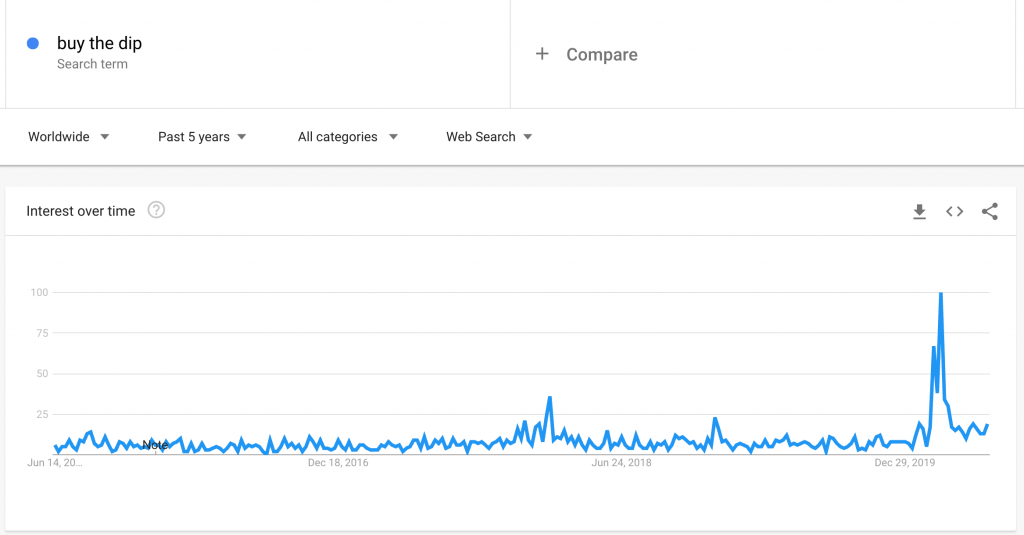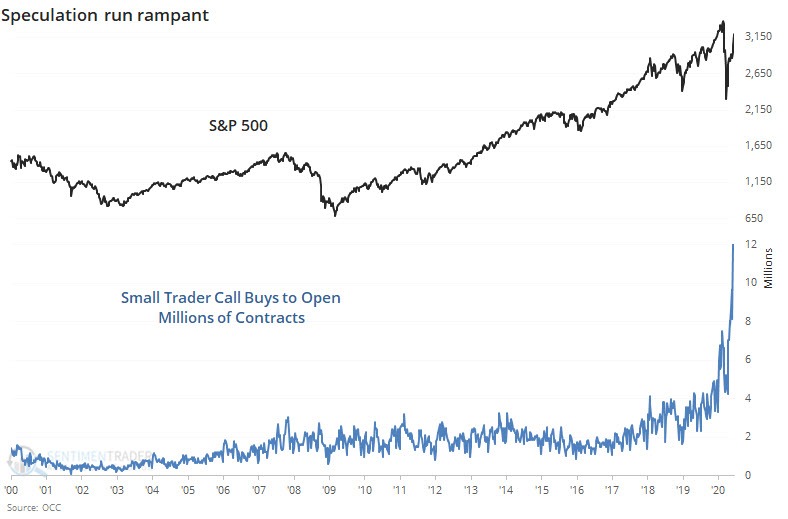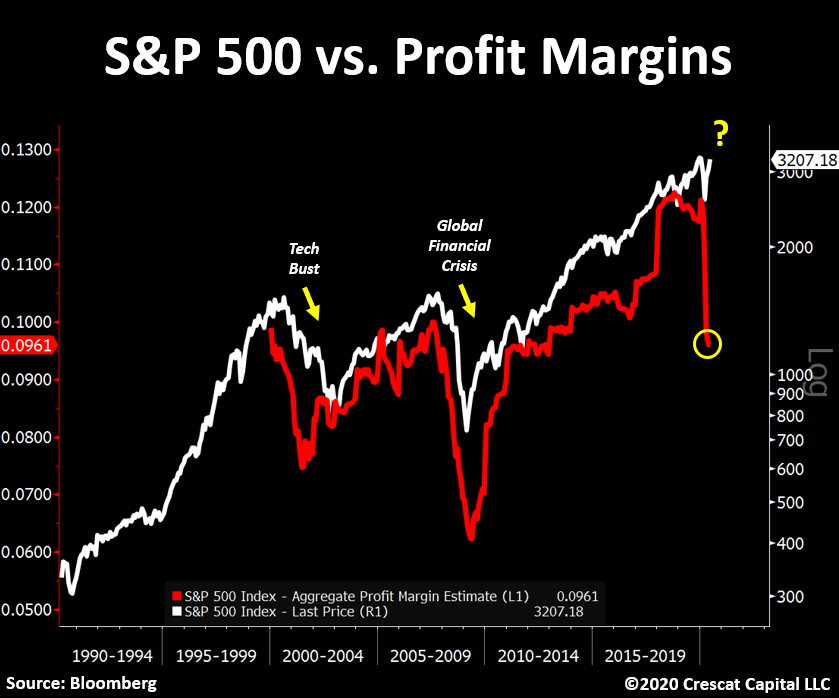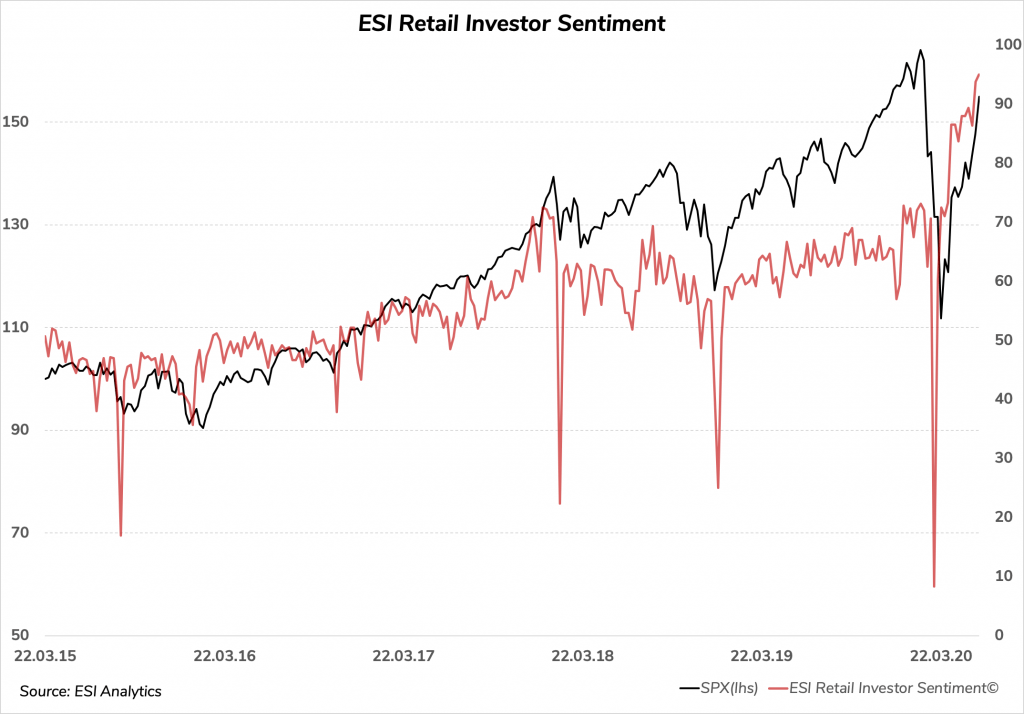Equities puzzled investors lately. A market crash led to a v-shaped rally that carried the broad market near all-time highs. It was the sharpest recovery for U.S. equities throughout our entire dataset that spans over 150 years. Moreover, that happened during the most significant economic crisis since the Great Depression. This write-up discusses the reasons behind the most recent rally and shows that fundamentals are likely to end the party very soon.
Source: Google
Speculation
A speculative bubble is probably the dominating force that drove equities up. The prevailing narratives are that equities always increase, the Fed prevents markets from falling, and “buy the dip” is a profitable investment strategy. Not surprisingly, investors had that in mind as equities tumbled earlier this year. The first chart shows worldwide google searches for the string “buy the dip” over the past five years. These peaked during the mid-March selloff and retail investors rushed in to buy the dip. Evidence, such as Robinhood holdings and small trader call option positioning, confirms the thesis that the rally was driven by speculative demand. Liquidity from retail investors found its way into the market in an unprecedented manner.
Source: sentimentrader.com
Fundamentals
Fundamentals do not confirm the most recent rally. Long-term valuation gauges, such as the 10-year cyclically-adjusted P/E ratio (CAPE), show that U.S. equities are very expensive relative to the past 150 years. CAPE is trading well above 30 versus its long-term average of roughly 17. Reality catches up with fantasy sooner or later. A pandemic led to the most severe recession since the Great Depression.
Source: Guggenheim Investments, S&P Global Ratings
The economy did not rebound in a v-shaped manner as equities suggest. Instead, businesses burned capital during the lockdown and a wave of defaults is right ahead of us. The chart above compares the previous two crises to today’s environment. Broad-based unemployment is likely to bring the default rate closer to what we witnessed in 2009 than in 2000. That will pull out liquidity from financial markets and catch retail speculators with their pants down.
Source: Bloomberg, Crescat Capital LLC
Conclusion
The running gag became that “Robinhood traders are longer irrational than hedge fund managers solvent”. However, sentiment indicators signal that retail is all in already. Moreover, technicals reveal the first signs of exhaustion for equities. Another attack towards the most recent highs is likely but does not invalidate the case for a subsequent bear market. Short-term strength indicators signal residual buying demand, which hints to a final leg of roughly 10% above Thursday’s low. Nonetheless, mid-term risks overweight on the downside and a sustained break below 2,950 in the S&P 500 signals that the party is over. The bottom line is that evidence suggests that the trend is about to reverse. Fundamentals are going to pop the speculative bubble probably sooner rather than later.
The above is a matter of opinion provided for general information purposes only and is not intended as investment advice. Information and analysis above are derived from sources and utilising methods believed to be reliable, but we cannot accept responsibility for any losses you may incur as a result of this analysis. Individuals should consult with their personal financial advisors. Reproduction without ESI Analytics’ prior consent is strictly forbidden.
Recommended Content
Editors’ Picks
EUR/USD retreats from daily highs, holds above 1.0800

EUR/USD loses traction but holds above 1.0800 after touching its highest level in three weeks above 1.0840. Nonfarm Payrolls in the US rose more than expected in June but downward revisions to May and April don't allow the USD to gather strength.
GBP/USD struggles to hold above 1.2800 after US jobs data

GBP/USD spiked above 1.2800 with the immediate reaction to the mixed US jobs report but retreated below this level. Nonfarm Payrolls in the US rose 206,000 in June. The Unemployment Rate ticked up to 4.1% and annual wage inflation declined to 3.9%.
Gold approaches $2,380 on robust NFP data

Gold intensifies the bullish stance for the day, rising to the vicinity of the $2,380 region following the publication of the US labour market report for the month of June. The benchmark 10-year US Treasury bond yield stays deep in the red near 4.3%, helping XAU/USD push higher.
Crypto Today: Bitcoin, Ethereum and Ripple lose key support levels, extend declines on Friday

Crypto market lost nearly 6% in market capitalization, down to $2.121 trillion. Bitcoin (BTC), Ethereum (ETH) and Ripple (XRP) erased recent gains from 2024.
French Elections Preview: Euro to “sell the fact” on a hung parliament scenario Premium

Investors expect Frances's second round of parliamentary elections to end with a hung parliament. Keeping extremists out of power is priced in and could result in profit-taking on Euro gains.




